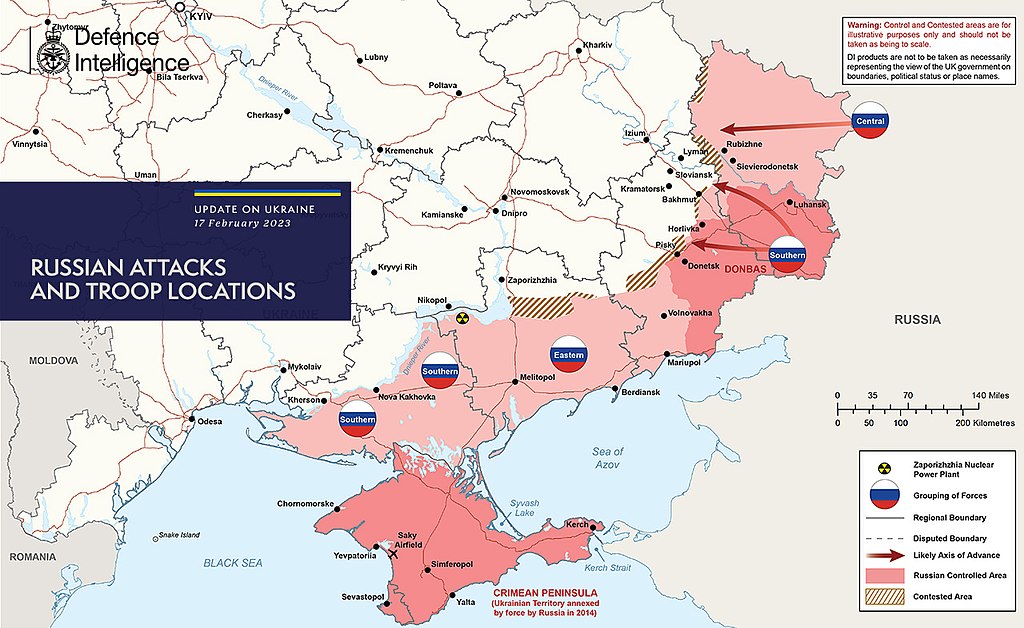One year has passed since the dawn of Feb. 24, 2022, the watershed date when Russian troops launched a large-scale aggression against Ukraine that continues to this day.
With his very own blitzkrieg, Russian president Vladimir Putin had plotted to take over his western neighbor in a matter of weeks, trying to glorify Moscow’s restored superpower status. In an ironic twist, however, it turned out to be the staunch resilience of the Ukrainian people and army that actually came to be glorified over the past year.
One year into the aggression, the Russian attack seems to have taken on all the contours of self-sabotage.
Mr. Putin had set out to oust the “neo-Nazi”, pro-Western regime led by Volodymyr Zelensky. He made him the most popular serving president in Ukraine’s history instead. Mr. Putin believed that the attack would cause a standoff in the West, assuming that Europeans all too dependent on Russian gas and a U.S. leadership too busy in a new cold war with China would turn a blind eye to what was happening in the heart of Europe. They did not.
Not only has NATO resurrected itself from its “brain-dead” phase, as French President Emmanuel Macron dubbed it just in 2019 – all the way to welcoming historically neutral Finland and Sweden into the club – but America and its European allies have also pumped more than $130 billion in military and humanitarian aid into Kyiv’s coffers, supplying it with modern military equipment that have effectively stalled Moscow’s advance.
Mr. Putin had also planned to restore Russia’s role as a superpower as in Soviet times. So far, however, he has succeeded only in making his country a pariah nation in a way that possibly even Stalin’s USSR never had been.

Russian troops had launched their Feb. 24 assault by shelling the entire country as more than 200,000 troops invaded from land borders in the north, east, and south.
Strategically, the attack from the north was aimed at taking over Kyiv and other government headquarters in a checkmate move so that a new pro-Russian puppet executive could be installed swiftly. The attack from the east was meant to take over the Donbass, a region culturally and geographically close to Russia that has been waging a civil war against the regular Ukrainian army since 2014. Finally, the attack from the south served to territorially weld the Donbass and Crimea, which Moscow’s forces have occupied since 2014 and that was connected by land to Russian territory only through a now-destroyed bridge.
The extremely harsh early weeks of the war, however, confronted Moscow with tenacious Ukrainian resistance subsidized by the West. That led Russians to abandon its high hopes of regime change and focus on the East-South corridor instead.
Last September, the Kremlin rushed to unilaterally annex four regions in southern and eastern Ukraine – that is Zaporizhzhia and Cherson in the south, and Donetsk and Lugansk in the east. In doing so, Putin allegedly accomplished his minimal goal, which is to aggregate the Donbass to Russian territory and land-connect it with Crimea.
However, what might be seen as a sign of strength is most likely to be interpreted as a sign of weakness. Strikingly, Russia’s annexations were not preceded by significant territorial advances, which Russian troops have virtually failed to make since May. The Kremlin’s haste may thus be justified by sheer fear of being forced to retreat. By characterizing the four annexed regions as Russian sovereign territory, Mr. Putin has made it clear that attacking them would be considered a full-fledged attack on Russia, which would consequently expose the attackers to possible nuclear retaliation.
To date, the nuclear card looks indeed the real wild card in Putin’s deck. That the Russian president periodically threatens to use it as a bogeyman is a reliable indicator that Russia’s campaign in Ukraine is definitely not going as planned.

What to expect then? In the coming weeks and months, the Russian military is expected to intensify its offensive on the South and East, putting a strain on Ukrainian defense lines. However, U.S. President Joe Biden has reiterated that the West will “watch its back” and provide all the weapons and ammunition the Ukrainians will need, perhaps even long-sought military jets.
On Russia’s side, instead, the role of China will have to be monitored. Beijing has so far refused to explicitly condemn Moscow’s aggression, calling for peace instead and accusing the West of provoking the confrontation. That would dramatically change if the Chinese were to supply weapons to Russia in the near future, as U.S. intelligence fears.
A year inside the war, we may only be at the beginning












